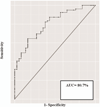Neuropathologic substrates of Parkinson disease dementia
- PMID: 23037886
- PMCID: PMC3484250
- DOI: 10.1002/ana.23659
Neuropathologic substrates of Parkinson disease dementia
Abstract
Objective: A study was undertaken to examine the neuropathological substrates of cognitive dysfunction and dementia in Parkinson disease (PD).
Methods: One hundred forty patients with a clinical diagnosis of PD and either normal cognition or onset of dementia 2 or more years after motor symptoms (PDD) were studied. Patients with a clinical diagnosis of dementia with Lewy bodies were excluded. Autopsy records of genetic data and semiquantitative scores for the burden of neurofibrillary tangles, senile plaques, Lewy bodies (LBs), and Lewy neurites (LNs) and other pathologies were used to develop a multivariate logistic regression model to determine the independent association of these variables with dementia. Correlates of comorbid Alzheimer disease (AD) were also examined.
Results: Niney-two PD patients developed dementia, and 48 remained cognitively normal. Severity of cortical LB (CLB)/LN pathology was positively associated with dementia (p < 0.001), with an odds ratio (OR) of 4.06 (95% confidence interval [CI], 1.87-8.81), as was apolipoprotein E4 (APOE4) genotype (p = 0.018; OR, 4.19; 95% CI, 1.28-13.75). A total of 28.6% of all PD cases had sufficient pathology for comorbid AD, of whom 89.5% were demented. The neuropathological diagnosis of PDD+AD correlated with an older age of PD onset (p = 0.001; OR, 1.12; 95% CI, 1.04-1.21), higher CLB/LN burden (p = 0.037; OR, 2.48; 95% CI, 1.06-5.82), and cerebral amyloid angiopathy severity (p = 0.032; OR, 4.16; 95% CI, 1.13-15.30).
Interpretation: CLB/LN pathology is the most significant correlate of dementia in PD. Additionally, APOE4 genotype may independently influence the risk of dementia in PD. AD pathology was abundant in a subset of patients, and may modify the clinical phenotype. Thus, therapies that target α-synuclein, tau, or amyloid β could potentially improve cognitive performance in PD.
Copyright © 2012 American Neurological Association.
References
-
- Aarsland D, Andersen K, Larsen JP, Lolk A, Kragh-Sorensen P. Prevalence and characteristics of dementia in Parkinson disease: an 8-year prospective study. Archives of neurology. 2003 Mar;60(3):387–392. - PubMed
-
- Buter TC, van den Hout A, Matthews FE, Larsen JP, Brayne C, Aarsland D. Dementia and survival in Parkinson disease: a 12-year population study. Neurology. 2008 Mar 25;70(13):1017–1022. - PubMed
-
- Lo RY, Tanner CM, Albers KB, et al. Clinical features in early Parkinson disease and survival. Archives of neurology. 2009 Nov;66(11):1353–1358. - PubMed
-
- Emre M, Aarsland D, Brown R, et al. Clinical diagnostic criteria for dementia associated with Parkinson's disease. Mov Disord. 2007 Sep 15;22(12):1689–1707. quiz 837. - PubMed
Publication types
MeSH terms
Substances
Grants and funding
LinkOut - more resources
Full Text Sources
Medical





